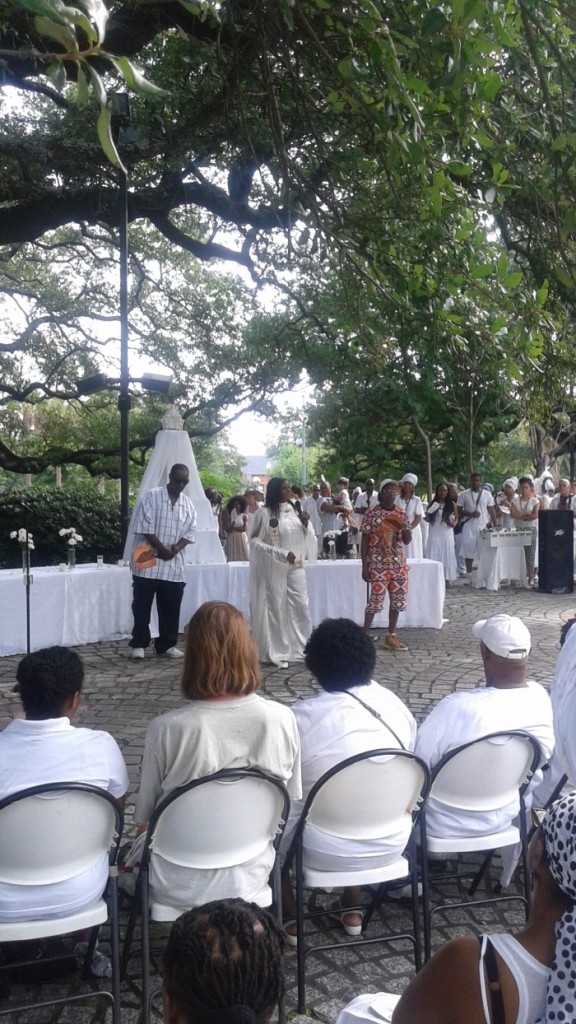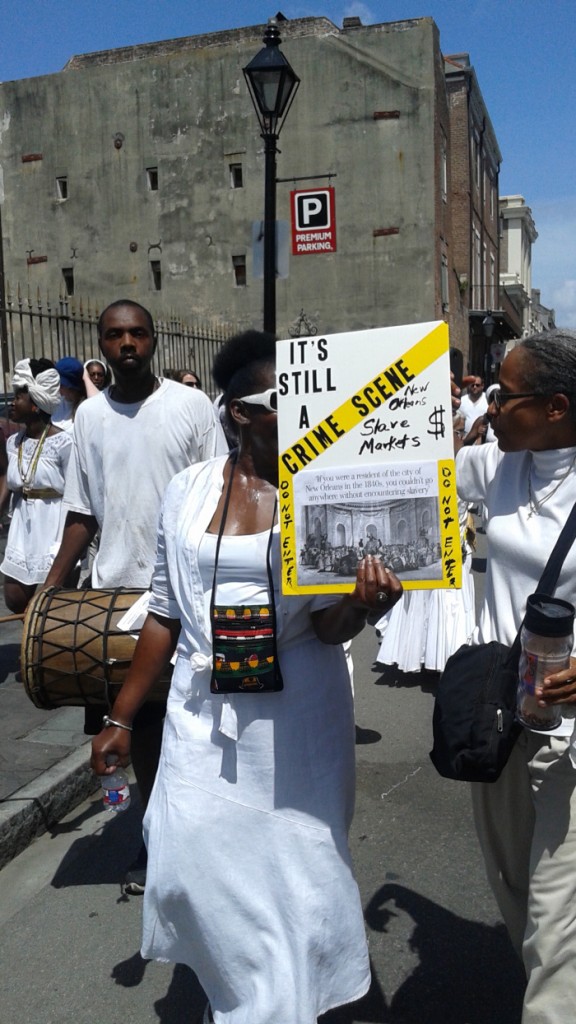black history, black futures, radical media, feminism
Maafa:
Reflections and
Pre-Thoughts
Attended Maafa yesterday (July 4, 2015), an event sponsored by the Ashé Cultural Arts Center of New Orleans:
“MAAFA is a Kiswahili word that means “great tragedy” or “horrific tragedy,” referring to the period called the Middle Passage or Transatlantic Slave Trade. During that time, millions of captives from Africa were brought to the Americas where they were used as a labor force, persecuted, beaten, and many, separated from their families forever. The Maafa commemoration offers an opportunity for the whole community to pause and reflect on this great transgression against humanity and to personally, as a community, agree to distance ourselves institutionally in word and deed from that transgression, its legacy and the evolved practice of racism in our civic, social, spiritual and personal lives.”
The community, Essence Festival goers, and visitors from around the world are invited to participate in this sacred ceremony where we honor our ancestors.
Hundreds of people attired in white clothing will be welcomed to Congo Square by the melodious sounds of the kora played by Senegal’s Morikeba Kouyate. They will gather, primarily, to pay tribute to African ancestors who died during the Middle Passage.
The ceremony includes multi-denominational words of healing, ancestral songs, a tribute to indigenous people of Louisiana, and the releasing of white peace doves.”
The Ashé Cultural Arts Center describes the New Orleans Maafa celebration as a branch of related celebrations “influenced by the work of St. Paul Baptist Church in Brooklyn, which was then led by New Orleans-born Rev. Johnnie Ray Youngblood.”
Diaspora at work. Black cultural production and political consciousness at work.
The Maafa celebration began at Congo Square with drumming, dancing, and speeches from interfaith leaders representing various traditions: Catholic, Muslim (via Nation of Islam), Buddhist, Jewish, Protestant, Rastafarianism, and Yoruba all made their presence known. Chief Warhorse and the Fi-Yi-Yi tribe represented the Mardi Gras Indians and black-Native traditions of New Orleans. Sage was burning and children raced around playing games. It had the feel of a black New Orleans family reunion. It had the feel of church. And it was HOT. The Caribbean sun was shining down on New Orleans that day.
After doves were released, drummers, dancers, and participants headed down Rampart, around the police station, then back up Basin and into the Treme. I downloaded Periscope and began taking live video as we walked. This was unlike any parade or secondline I’d ever participated in. Instead of a sense of release and joyful ecstasy, there was something calming in what we were doing. Marching together as a black New Orleans community and in solidarity with antiracist whites and allies of color, doing it as a ritual on the fourth of July made sense.
I realized I’m normally anxious on the Fourth, on edge all day because it is a holiday reminder that this nation owes its freedom to enslaving black people and doing its best to extinguish Native inhabitants. And over the course of just this year, in the continued aftermath of Ferguson, the murder of nine people at Mother Emanuel, the triggering assault on a fourteen year old girl at a pool in McKinney, TX, the acquittal of Rekia Boyd’s murderer…
This 4th of July, there would be no ignoring how little #blacklivesmatter to institutions with arms in the U.S. Or the fact that black people are still being killed in the name of freedom.
And yet, I also felt that with every step I took I was reclaiming space in the city for my tribe. In our mass memorial, we were honoring ancestors knitting together a different kind of memory of this place.
Some people danced as they walked. Some people drummed. Many people chatted and sang. There was troupe of African dancers, seven or eight women, who led the way behind the Maafa banner. Mostly, we walked. I saw Nola Wildseeds, and BYP 100 Nola squad members, Casa Samba dancers and members of various Afro-Atlantic spiritual communities, along with prison abolitionists, musicians, and academics in the crowd.
This year, the procession’s first stop was St. Augustine Catholic Church at the Tomb of the Unknown Slave:
From there, we headed into the Quarter, down Royal Street on its busiest day of the week (disrupt, disrupt) and stopped at the Louisiana Supreme Court Building. There a statue greets visitors–the Honorable Edward Douglass White, Jr., one of the judges who sided with segregation in the Plessy v. Ferguson case. As a young man, White was also a member of both the Pickwick Club and the Crescent City White League. The Crescent City White League, formed in 1874, was a paramilitary organization of Democrats and other pro-Confederate white men that terrorized black men, women, and children, and white Republican or moderate allies during Reconstruction.
The year it was formed, the Crescent City White League led an armed uprising against the Republican Reconstruction government. Known as the Battle of Liberty Place, white Democrats faced off against a smaller multiracial city police force and state militia. They took over government buildings in the city and held them for three days. Estimates vary, but at least 30 officers and militiamen were killed, a number which does not include civilian casualties and property damage as a result of the altercation. It also doesn’t include the violence and threat of violence imposed on and felt by residents of black New Orleans–freed, long free, ancien French, Spanish, Caribbean, African, and Anglo-American families–attempting to build new lives in the aftermath of slavery.
From historian Lawrence Powell:
In 1876, white Democrats “redeemed” New Orleans and Louisiana from Republican rule.
The Liberty Place monument, which I posted about here, here, here, and hereover at Diaspora Hypertext; and which Jordan Flaherty recently wrote about on the Louisiana Justice Institute Blog, has these words carved into the base:
“United States troops took over the state government and reinstated the usurpers but the national election November 1876 recognized white supremacy in the South and gave us our state.”
So when we stopped at the Louisiana Supreme Court building, this was no small matter:
The procession continued around the corner to the site of the offices of the La Tribune de la Nouvelle-Orleans, a French-English newspaper founded by Charles Roudanez, a free man of color, and edited by Paul Trevigne, another free man of color and white abolitionist Jean Charles Houzeau. At the end of the block, the procession stopped again, this time in front of Pierre Maspero’s Cafe, which bears a plaque memorializing its history as a slave exchange:

…and around the corner from the Omni Royal Orleans Hotel, once known as the St. Louis Hotel, and considered the wealthiest and largest hotel in town. The St Louis Hotel is the site of the rotunda made famous in this image:

The New Orleans slave market, the busiest slave market in the United States and the most important hub of the entire U.S. domestic slave trade, was profiled most recently in the Purchased Lives exhibit at the Historic New Orleans Collection, curated by Erin Greenwald (more here). The St. Louis Hotel (and its auction block) stood until 1916, long after emancipation, a symbol and a threat.
From these two historic New Orleans slave auction sites we moved through the Quarter and down Decatur to Bienville Place where a mammoth statue of Bienville rests. According to Sally Asher, the monument features Jean-Baptiste Le Moyne, Sieur de Bienville standing upright next to Father Anastase Douay and an anonymous Native man. It was designed by Angela Gregory, a local sculptor.

Maafa participants draped the Pan-African flag on the shoulders of the anonymous Native man as Leon Waters gave a history of the founding of the city and the beginning of the slave trade. Waters did not mince words. He called for all monuments to white supremacy to be torn down.
The march continued to the river to Woldenburg Riverfront Park where we marked the Mississippi river for all of its meanings–a place where slaves met their fate and became unfree laborers working for slaveowners on both sides of the river, where so many died during Hurricanes Katrina and Rita, but also as a constant source of renewal and resurgence and return. A river I adore and keep coming back to.
The final ceremony of the Maafa celebration was simple and sweet. We threw white carnations into the river in honor of someone we loved who had passed, recently or long ago.
My great-grandmother
My grandfather
Clyde Woods #AlwaysClydeWoods
Jim Mcleod
Stephanie Camp
The enslaved and the free before me
The fallen and the righteous dead and the ones who paved the way….
++++++++++++
>via: http://diasporahypertext.com/2015/07/05/maafa-reflections-and-pre-thoughts/




